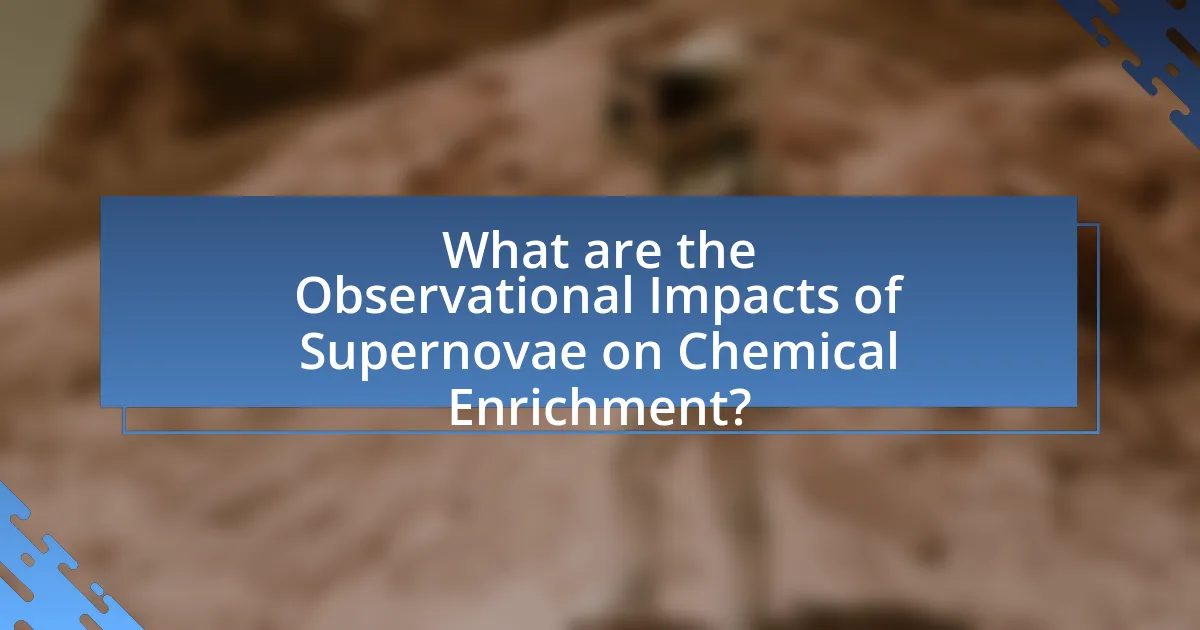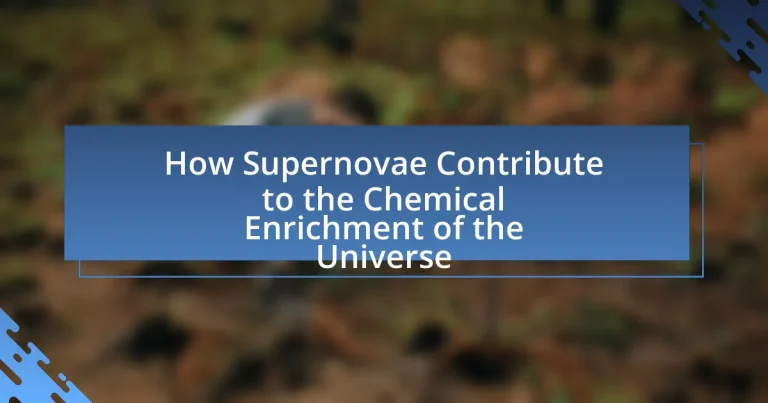Supernovae are explosive events marking the end of a star’s life cycle, crucial for the chemical enrichment of the universe. They disperse heavy elements such as carbon, oxygen, and iron into the interstellar medium, which are essential for the formation of new stars and planets. The article explores the mechanisms behind supernovae, their types, and their significant role in cosmic evolution, including how they influence the lifecycle of stars and the formation of galaxies. Additionally, it discusses the processes of nucleosynthesis during supernova explosions and the implications for understanding the universe’s evolution, including dark matter and dark energy.

What are Supernovae and Their Role in the Universe?
Supernovae are explosive events that occur at the end of a star’s life cycle, resulting in the ejection of the star’s outer layers into space. These explosions play a crucial role in the universe by dispersing heavy elements, such as carbon, oxygen, and iron, which are synthesized during the star’s lifetime and in the explosion itself. According to research, supernovae contribute significantly to the chemical enrichment of the interstellar medium, providing the building blocks for new stars and planets. For instance, it is estimated that supernovae are responsible for producing about half of the universe’s elements heavier than helium, as detailed in studies published in the journal “Nature” by authors such as Woosley and Weaver.
How do Supernovae occur?
Supernovae occur when a star exhausts its nuclear fuel and undergoes a catastrophic explosion. This process can happen in two primary ways: in massive stars, when they run out of fuel, their core collapses under gravity, leading to a supernova; in binary systems, a white dwarf can accumulate material from a companion star until it reaches a critical mass, resulting in a thermonuclear explosion. These explosions release enormous amounts of energy and eject stellar material into space, contributing to the chemical enrichment of the universe by dispersing heavy elements formed during the star’s life cycle.
What are the different types of Supernovae?
There are two primary types of supernovae: Type I and Type II. Type I supernovae occur in binary star systems where one star is a white dwarf that accumulates matter from its companion until it reaches a critical mass, leading to a thermonuclear explosion. Type II supernovae result from the gravitational collapse of a massive star (at least eight times the mass of the Sun) after it exhausts its nuclear fuel, causing a violent explosion. These classifications are supported by the distinct light curves and spectra observed in each type, with Type I lacking hydrogen lines and Type II exhibiting strong hydrogen lines in their spectra.
What processes lead to a star becoming a Supernova?
A star becomes a supernova primarily through two processes: the core-collapse of massive stars and the thermonuclear explosion of white dwarfs. In the core-collapse scenario, when a massive star exhausts its nuclear fuel, it can no longer support itself against gravitational collapse, leading to a rapid implosion followed by a violent explosion. This process is supported by the fact that stars with masses greater than approximately eight times that of the Sun typically undergo this transformation, resulting in a supernova of type II.
In the case of white dwarfs, a supernova occurs when the star accumulates enough mass from a companion star to exceed the Chandrasekhar limit of about 1.4 solar masses. This leads to a runaway thermonuclear reaction, resulting in a type Ia supernova. The occurrence of these supernovae is evidenced by the consistent brightness observed in distant galaxies, which allows astronomers to use them as standard candles for measuring cosmic distances.
Why are Supernovae important for cosmic evolution?
Supernovae are crucial for cosmic evolution because they facilitate the chemical enrichment of the universe by dispersing heavy elements into the interstellar medium. When a massive star undergoes a supernova explosion, it releases a vast amount of energy and ejects materials, including elements like carbon, oxygen, and iron, which are essential for the formation of planets and life. This process contributes to the recycling of matter in the universe, allowing new stars and planetary systems to form from the enriched gas and dust. Studies indicate that supernovae are responsible for producing about half of the elements heavier than helium in the universe, significantly influencing the chemical composition of galaxies and the evolution of stellar populations.
How do Supernovae influence the lifecycle of stars?
Supernovae significantly influence the lifecycle of stars by marking the explosive end of massive stars and facilitating the creation of new stellar material. When a massive star exhausts its nuclear fuel, it undergoes a gravitational collapse, leading to a supernova explosion that disperses elements into the surrounding space. This process enriches the interstellar medium with heavy elements, such as carbon, oxygen, and iron, which are essential for the formation of new stars and planetary systems. Historical observations, such as the supernova SN 1987A, demonstrate how these explosions contribute to the chemical evolution of galaxies by providing the necessary building blocks for subsequent generations of stars.
What role do Supernovae play in galaxy formation?
Supernovae play a crucial role in galaxy formation by contributing to the chemical enrichment of the interstellar medium. When a massive star explodes as a supernova, it disperses heavy elements, such as carbon, oxygen, and iron, into space. This process enriches the surrounding gas and dust, providing the necessary materials for the formation of new stars and planets. Studies indicate that supernovae are responsible for producing about half of the universe’s heavy elements, which are essential for the development of complex structures within galaxies. The energy released during a supernova also triggers shock waves that can compress nearby gas clouds, leading to further star formation.

How do Supernovae Contribute to Chemical Enrichment?
Supernovae contribute to chemical enrichment by dispersing heavy elements into the interstellar medium during their explosive death. When a massive star exhausts its nuclear fuel, it undergoes a supernova explosion, which synthesizes and ejects elements such as carbon, oxygen, iron, and other heavier elements formed through nucleosynthesis. This process enriches the surrounding gas and dust, providing the building blocks for new stars, planets, and potentially life. Studies indicate that supernovae are responsible for producing about half of the universe’s carbon and oxygen, essential for forming complex molecules.
What elements are produced during a Supernova explosion?
During a supernova explosion, elements such as iron, nickel, and various heavier elements like gold, silver, and uranium are produced. The intense heat and pressure during the explosion facilitate nuclear fusion processes that create these elements from lighter ones. Specifically, supernovae are responsible for synthesizing approximately half of the elements heavier than iron through rapid neutron capture processes, known as the r-process. This contribution is crucial for the chemical enrichment of the universe, as these newly formed elements are dispersed into space, enriching the interstellar medium and contributing to the formation of new stars and planets.
How are heavy elements synthesized in Supernovae?
Heavy elements are synthesized in supernovae through a process called nucleosynthesis, which occurs during the explosive death of massive stars. In these events, the extreme temperatures and pressures enable nuclear reactions that fuse lighter elements into heavier ones, such as iron, nickel, and elements beyond iron in the periodic table. Specifically, during the core collapse of a supernova, rapid neutron capture processes (r-process) and explosive nucleosynthesis occur, resulting in the formation of heavy elements. Observations of supernova remnants and the distribution of heavy elements in the universe provide evidence for this synthesis, confirming that supernovae are a primary source of heavy elements in the cosmos.
What is the significance of these elements for future star systems?
The significance of elements produced by supernovae for future star systems lies in their role as fundamental building blocks for new stars and planets. These elements, including carbon, oxygen, and iron, are ejected into space during a supernova explosion, enriching the interstellar medium. This enriched medium provides the necessary materials for the formation of new stars, which can host planetary systems capable of supporting life. Research indicates that the presence of heavy elements is crucial for the development of terrestrial planets, as they contribute to the formation of rocky bodies. For instance, studies show that the abundance of metals in a star’s environment correlates with the likelihood of forming Earth-like planets. Thus, the elements from supernovae are essential for the chemical evolution of the universe and the potential emergence of life in future star systems.
How do Supernovae distribute elements throughout the universe?
Supernovae distribute elements throughout the universe by explosively ejecting material into space, enriching the interstellar medium with heavy elements. During a supernova explosion, the core of a massive star collapses, leading to a violent outflow of gas and dust that carries elements such as carbon, oxygen, and iron, which are synthesized during the star’s life cycle. This process contributes to the chemical enrichment of the universe, as evidenced by observations of supernova remnants that show a diverse array of elements scattered across vast distances. Studies, such as those conducted by the Hubble Space Telescope, have identified specific elemental signatures in the remnants of supernovae, confirming their role in distributing these elements throughout galaxies.
What mechanisms are involved in the dispersal of materials?
The mechanisms involved in the dispersal of materials from supernovae include shock waves, stellar winds, and nucleosynthesis. Shock waves generated by the explosive event propel material into space at high velocities, effectively distributing elements synthesized during the explosion. Stellar winds from massive stars also contribute to the dispersal of lighter elements prior to the supernova event. Nucleosynthesis within the supernova produces heavy elements, which are then released into the interstellar medium, enriching it with new materials essential for the formation of stars and planets. This process has been evidenced by observations of supernova remnants, which show a mix of elements such as iron and nickel, confirming the role of supernovae in the chemical enrichment of the universe.
How does this distribution affect the interstellar medium?
The distribution of elements from supernovae significantly enriches the interstellar medium with heavy elements. This process occurs when supernova explosions disperse materials such as carbon, oxygen, and iron into the surrounding space, enhancing the chemical diversity of the interstellar medium. Studies show that approximately 90% of the iron in the universe is produced by supernovae, which directly contributes to the formation of new stars and planets by providing essential building blocks for subsequent generations of celestial bodies.

What are the Observational Impacts of Supernovae on Chemical Enrichment?
Supernovae significantly impact chemical enrichment by dispersing heavy elements into the interstellar medium. These explosive events synthesize and release elements such as carbon, oxygen, and iron, which are crucial for the formation of new stars and planets. Observations from telescopes, such as the Hubble Space Telescope, have documented the presence of these elements in supernova remnants, confirming their role in enriching surrounding gas clouds. For instance, the supernova remnant Cassiopeia A has been studied extensively, revealing a composition rich in elements produced during the explosion, thus providing direct evidence of supernovae’s contribution to the chemical evolution of galaxies.
How do astronomers study Supernovae and their remnants?
Astronomers study supernovae and their remnants primarily through observational techniques using various wavelengths of light, including optical, radio, and X-ray observations. These observations allow astronomers to analyze the light curves and spectra of supernovae, which provide insights into their explosion mechanisms and the elements produced during the event. For instance, the study of Type Ia supernovae has been crucial in understanding cosmic distances and the expansion of the universe, as evidenced by the discovery of dark energy. Additionally, astronomers utilize telescopes like the Hubble Space Telescope and ground-based observatories to monitor supernova remnants, which reveal the distribution of heavy elements synthesized during the explosion. The analysis of these remnants, such as the Crab Nebula, shows how supernovae contribute to the chemical enrichment of the interstellar medium, influencing star formation and the evolution of galaxies.
What tools and methods are used to observe Supernovae?
Astronomers use telescopes, both ground-based and space-based, along with spectroscopy to observe supernovae. Ground-based telescopes, such as the Keck Observatory, provide high-resolution images, while space-based telescopes like the Hubble Space Telescope avoid atmospheric interference, allowing for clearer observations. Spectroscopy is employed to analyze the light emitted by supernovae, revealing their composition, velocity, and distance. This method has been crucial in understanding the elements produced during supernova explosions, which contribute to the chemical enrichment of the universe.
How do observations contribute to our understanding of chemical enrichment?
Observations significantly enhance our understanding of chemical enrichment by providing empirical data on the distribution and composition of elements in the universe. For instance, telescopic observations of supernovae reveal the specific elements ejected during these explosive events, such as iron and nickel, which contribute to the chemical makeup of surrounding interstellar matter. Studies, like those conducted by the Supernova Legacy Survey, have shown that the spectra of supernovae can be analyzed to identify the chemical signatures of these elements, confirming their role in enriching the intergalactic medium. This empirical evidence allows scientists to trace the processes of nucleosynthesis and the recycling of materials in galaxies, thereby deepening our comprehension of how supernovae influence the chemical evolution of the universe.
What are the implications of Supernovae for understanding the universe’s evolution?
Supernovae significantly impact our understanding of the universe’s evolution by acting as primary sources of heavy elements and influencing cosmic structure formation. When a star explodes as a supernova, it disperses elements like carbon, oxygen, and iron into the interstellar medium, enriching it and enabling the formation of new stars and planets. This process contributes to the chemical evolution of galaxies, as evidenced by observations of supernova remnants and the elemental composition of distant galaxies. Studies, such as those conducted by the Supernova Legacy Survey, demonstrate that the rate of supernovae correlates with star formation rates, highlighting their role in shaping the cosmic environment and influencing the evolution of galaxies over time.
How do Supernovae inform theories about dark matter and dark energy?
Supernovae provide critical insights into theories about dark matter and dark energy by serving as standard candles for measuring cosmic distances and the expansion rate of the universe. The observations of Type Ia supernovae have revealed that the universe is expanding at an accelerating rate, which supports the existence of dark energy as a driving force behind this acceleration. Additionally, the distribution and behavior of supernovae in different regions of the universe help astronomers infer the presence of dark matter, as the gravitational effects observed in supernovae environments indicate more mass than is visible. This relationship is evidenced by the correlation between supernova brightness and the underlying mass distribution, which aligns with dark matter models.
What future research is needed to further explore Supernovae’s role?
Future research needed to further explore supernovae’s role includes detailed studies on the nucleosynthesis processes occurring during supernova explosions. Understanding the specific isotopes produced and their contributions to the chemical enrichment of the universe is crucial. For instance, research should focus on the varying types of supernovae, such as Type Ia and Type II, and their distinct contributions to the elemental composition of galaxies. Additionally, advancements in observational techniques, such as high-resolution spectroscopy, can provide insights into the remnants of supernovae and their surrounding environments, allowing for a better understanding of how these events influence star formation and the interstellar medium.
What practical insights can we gain from studying Supernovae?
Studying supernovae provides practical insights into the processes of chemical enrichment in the universe, as they are responsible for dispersing heavy elements into interstellar space. Supernovae explosions synthesize and release elements such as carbon, oxygen, and iron, which are essential for the formation of planets and life. For instance, the Type II supernova SN 1987A, observed in 1987, demonstrated the production of heavy elements and their subsequent distribution, confirming theories about nucleosynthesis. This understanding aids astronomers in tracing the evolution of galaxies and the formation of new stars, thereby enhancing our knowledge of cosmic evolution and the lifecycle of matter in the universe.
How can knowledge of Supernovae influence astrophysics and cosmology?
Knowledge of supernovae significantly influences astrophysics and cosmology by providing insights into the life cycles of stars and the chemical enrichment of the universe. Supernovae are critical for understanding stellar evolution, as they mark the explosive end of massive stars, leading to the dispersal of heavy elements into the interstellar medium. This process contributes to the formation of new stars and planetary systems, thereby shaping the chemical composition of galaxies.
Furthermore, supernovae serve as standard candles for measuring cosmic distances, which aids in the understanding of the universe’s expansion rate. The discovery of the accelerated expansion of the universe, attributed to dark energy, was made possible through observations of distant supernovae. This connection between supernovae and cosmic phenomena underscores their importance in advancing theoretical models and observational techniques in both astrophysics and cosmology.
What lessons can be learned about the life cycle of stars and galaxies?
The life cycle of stars and galaxies teaches that stars undergo distinct stages, from formation in nebulae to eventual death, often resulting in supernovae, which play a crucial role in enriching the universe with heavy elements. This process illustrates how massive stars fuse lighter elements into heavier ones during their lifetimes, and upon exploding as supernovae, they disperse these elements into the interstellar medium, contributing to the formation of new stars and planets. For example, elements like carbon, oxygen, and iron, essential for life, are produced in the cores of stars and released during supernova events, demonstrating the interconnectedness of stellar evolution and cosmic chemical enrichment.


